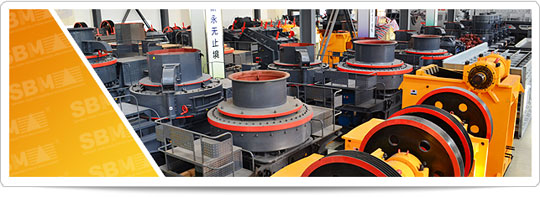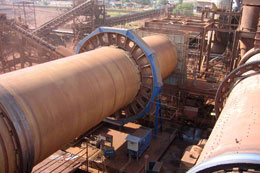-
Sand Making Crusher
- PCL-Vertical Shaft Impact Crusher
- SBM Hydraulic VSI Crusher
- VSI5X Series Impact Crusher

Rotary Dryer

Rotary dryers potentially represent the oldest continuous and undoubtedly the most common high volume dryer used in industry, and it has evolved more adaptations of the technology than any other dryer classification. It could be used in iron ore beneficiation, gold ore beneficiation, ect.
Rotary dryers are a class of dryer commonly used in industry to dry particulate solids. They are made of a long cylindrical shell that is rotated. The shell is usually slightly inclined to the horizontal to induce solids flow from one end of the dryer to the other. In direct heat rotary dryers, a hot gas flowing through the dryer provides the heat required for vaporization of the water.

To promote gas-solid contact, most direct heat dryers have flights, placed parallel along the length of the shell, which lift solids and make them rain across the dryer section. The transport of solids through the drum takes place by the action of the solids cascading from the flights, each cascade comprising the cycle of lifting on a flight and falling through the air stream. Thus, good flight design is essential to promote the gas-solid contact that is required for rapid and homogeneous drying.
Review of others major dryer types
Pneumatic/Flash Dryer
The pneumatic or 'flash' dryer is used with products that dry rapidly owing to the easy removal of free moisture or where any required diffusion to the surface occurs readily. Drying takes place in a matter of seconds. Wet material is mixed with a stream of heated air (or other gas), which conveys it through a drying duct where high heat and mass transfer rates rapidly dry the product. Applications include the drying of filter cakes, crystals, granules, pastes, sludges and slurries; in fact almost any material where a powdered product is required
Fluidised Bed Dryers
Fluid bed dryers are found throughout all industries, from heavy mining through food, fine chemicals and pharmaceuticals. They provide an effective method of drying relatively freeflowing particles with a reasonably narrow particle size distribution. In general, fluid bed dryers operate on a through-the-bed flow pattern with the gas passing through the product perpendicular to the direction of travel.
Radio frequency drying
In a radio frequency drying system, the RF generator creates an alternating electric field between two electrodes. The material to be dried is conveyed between the electrodes, where the alternating energy causes polar molecules in the water to continuously re-orient themselves to face opposite poles—much in the same way magnets move in an alternating magnetic field. The friction of this movement causes the water in the material to rapidly heat throughout the material’s entire mass.
- About Us
- |
- Service
- |
- News & Events
- |
- Contact Us
- |
- Resources
Aggregate Crusher
Artificial Sand Making
Ballast Crushing Machine
Basalt Stone Crusher
Barite Mine Process
Beneficiation Plant
Bentonite Crusher
Bentonite Milling
Calcium Carbonate Crusher
Calcium Carbonate Grinding
Cement Grinding
Concrete Crusher
Coal Crusher
Copper Crusher
Cement Mill
Chrome Mining Process
Copper ore Beneficiation
Coal Processing
Coal Pulvarizer
Feldspar Crushing
Feldspar Grinding
Flotation Machine
Gold Crusher
Gold Mine Equipment
Gold Processing Machinery
Granite Crusher
Granite Crushing Machine
Granite Quarry Equipment
Gypsum Crusher
Gypsum Mining
Gypsum Powder Production
Iron Ore Beneficiation
Iron Ore Crusher
Kaolin Processing Plant
Limestone Crusher
Silica Sand Crusher
Iron Ore Mining Equipment
Cement Production Line
Talc Production Line
Quartz Crushing Machine
Limestone Mining Process
Manganese Benificietion


